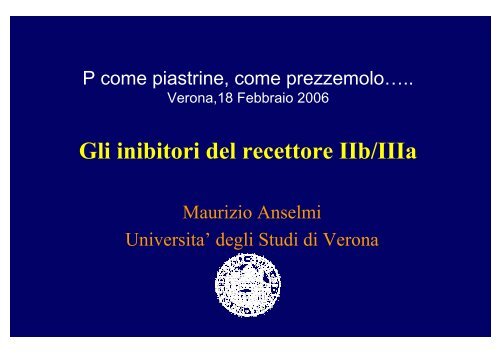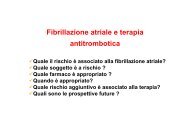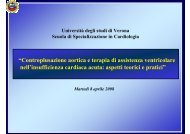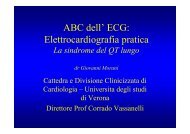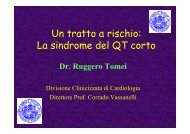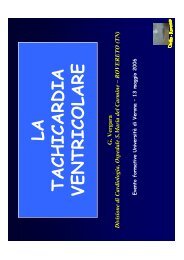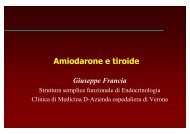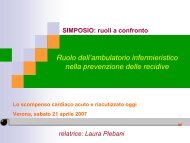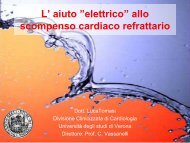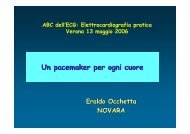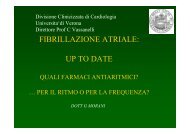Gli inibitori del recettore IIb/IIIa - Cuorediverona.it
Gli inibitori del recettore IIb/IIIa - Cuorediverona.it
Gli inibitori del recettore IIb/IIIa - Cuorediverona.it
Create successful ePaper yourself
Turn your PDF publications into a flip-book with our unique Google optimized e-Paper software.
P come piastrine, come prezzemolo…..<br />
Verona,18 Febbraio 2006<br />
<strong>Gli</strong> <strong>inib<strong>it</strong>ori</strong> <strong>del</strong> <strong>recettore</strong> <strong>IIb</strong>/<strong>IIIa</strong><br />
Maurizio Anselmi<br />
Univers<strong>it</strong>a’ degli Studi di Verona
Patogenesi <strong>del</strong>le Sindromi Coronariche Acute: Ruolo-Chiave<br />
<strong>del</strong>l’aggregazione piastrinica nella formazione <strong>del</strong> trombo<br />
Rottura di placca<br />
Adesione <strong>del</strong>le piastrine<br />
Attivazione e Aggregazione piastrinica<br />
Trombosi arteriosa parzialmente<br />
occludente e Angina Instabile<br />
o infarto non Q<br />
Microembolizzazione e Infarto non Q<br />
MI = myocardial infarction.<br />
Trombosi coronarica totalmente<br />
occludente e Infarto Q<br />
Adapted from Davies. Circulation. 1990;82(supl II):II-38. Wh<strong>it</strong>e. Am J Cardiol. 1997;80(suppl 4A):2B.
Formazione <strong>del</strong> trombo nelle ACS senza sopraslivellamento <strong>del</strong> tratto<br />
ST:l’aggregazione piastrinica è mediata dal <strong>recettore</strong> GP 2b-3a<br />
NSTE ACS sono causate da un<br />
Trombo ricco di piastrine<br />
Nelle coronarie<br />
Le piastrine si aggregano fra loro<br />
mediante il fibrinogeno che forma legami<br />
con i recettori GP 2b-3a a livello <strong>del</strong>la<br />
placca<br />
Unobstructed<br />
lumen<br />
GP <strong>IIb</strong>-<strong>IIIa</strong><br />
thrombus<br />
platelet<br />
fibrinogen<br />
Ruptured<br />
plaque<br />
Artery wall<br />
NSTE = non-ST-segment elevation; ACS = acute coronary syndromes; GP =glycoprotein.<br />
Adapted from Fintel and Ledley. Clin Cardiol. 2000;23(suppl V):V-1.
GP <strong>IIb</strong>-<strong>IIIa</strong> Inhib<strong>it</strong>ors:<br />
Meccanismo d’ Azione<br />
Vessel wall<br />
GP = glycoprotein; vWF = von Willebrand factor.<br />
Adapted from Fintel and Ledley. Clin Cardiol. 2000;23(suppl V):V-1.
GP <strong>IIb</strong>-<strong>IIIa</strong> Inhib<strong>it</strong>ors cost<strong>it</strong>uiscono l’unica terapia che blocca l’aggregazione piastrinica in<br />
risposta allo stimolo eserc<strong>it</strong>ato da tutti gli agonisti<br />
GP = glycoprotein; ADP = adenosine diphosphate; PAR = protease-activated receptor; AA = arachidonic acid; Tx = thromboxane.<br />
Adapted from Brogan. Ann Emerg Med. 2002;9:1029.
Cardiologia “De Gasperis”- Niguarda, Milano<br />
9
Cardiologia “De Gasperis”- Niguarda, Milano<br />
9
(Tirofiban)<br />
SMALL MOLECULES<br />
(Eptifibatide)<br />
(ReoPro)
Inib<strong>it</strong>ori GP<strong>IIb</strong>/<strong>IIIa</strong><br />
Artist’s conception.<br />
Piccole molecole<br />
(blocco compet<strong>it</strong>ivo)<br />
ReoPro ®<br />
(anticorpo monoclonale)
Recovery of platelet aggregation<br />
Clinical Considerations: Reversibil<strong>it</strong>y<br />
Platelet<br />
Aggregation<br />
100<br />
80<br />
60<br />
40<br />
20<br />
●<br />
●<br />
▲■<br />
●<br />
●<br />
▲<br />
■<br />
●<br />
■<br />
0<br />
0 6 12 18 24 30 36<br />
Hours<br />
■<br />
Normal return of platelet function<br />
■<br />
● Tirofiban<br />
▲ Eptifibatide<br />
■ Abciximab<br />
Adapted from Mousa, 1996.
Characteristics of GP <strong>IIb</strong>/<strong>IIIa</strong> Inhib<strong>it</strong>ors<br />
Abciximab Eptifibatide Tirofiban<br />
Monoclonal<br />
antibody fragment<br />
Small molecule Small molecule<br />
(KGD sequence) (RGD sequence)<br />
Platelet-Bound Half-life Long (2 hours) Short (secs) Short (secs)<br />
Plasma Half-life Short (mins) Long (2.5 hs) Long (~2 hs)<br />
Drug-to-Receptor Ratio 1.5–2.0 250–2,500* >250 †<br />
% of Dose in Bolus ~75% ‡
Trials Glycoprotein <strong>IIb</strong>/<strong>IIIa</strong><br />
<strong>IIIa</strong> inhib<strong>it</strong>ors<br />
Problematiche<br />
• Eterogene<strong>it</strong>a’ studi<br />
• Diverse molecole, dosaggi<br />
• Modal<strong>it</strong>a’ somministrazione/evento clinico<br />
• Rivascolarizzazione si/no<br />
• End-point<br />
(combinati)<br />
• Deduzioni da metanalisi
Patogenesi <strong>del</strong>le Sindromi Coronariche<br />
Acute<br />
NSTE ACS (UA/NSTE MI):<br />
Trombo parzialmente occludente<br />
( principalmente piastrinico)<br />
ST ↑ MI:<br />
trombo occlusivo (piastrine,globuli<br />
rossi, fibrina)<br />
Trombo interno alla placca<br />
( principalmente piastrine)<br />
Centro<br />
<strong>del</strong>la placca<br />
Trombo interno alla placca<br />
(principalmente piastrine)<br />
Centro<br />
<strong>del</strong>la placca<br />
NSTE = non-ST-segment elevation; ACS = acute coronary syndromes; UA = unstable angina; MI = myocardial infarction.<br />
Adapted from Davies. Circulation. 1990;82(supl II):II-38.
Sindromi Coronariche Acute<br />
ST-segment elevation<br />
MI<br />
Non-ST-segment<br />
elevation ACS
Sindromi Coronariche Acute<br />
ST-segment elevation<br />
MI<br />
Non-ST-segment<br />
elevation ACS
UA/NSTEMI e <strong>IIb</strong>/<strong>IIIa</strong><br />
Riduzione complicanze ischemiche<br />
(e morte) dopo PCI
8 16<br />
Lancet 1997; 349:1429-35<br />
35
Meta-analysis of <strong>IIb</strong>/<strong>IIIa</strong> Inhib<strong>it</strong>ion in PCI for 30-<br />
Day Mortal<strong>it</strong>y<br />
EPIC<br />
EPILOG<br />
RAPPORT<br />
CAPTURE<br />
Impact I<br />
Impact II<br />
Restore<br />
Epistent<br />
Espir<strong>it</strong><br />
ISAR 2<br />
Admiral<br />
Cadillac<br />
<strong>IIb</strong>/<strong>IIIa</strong> Inhib<strong>it</strong>or Better<br />
Placebo Better<br />
N<br />
2099<br />
2792<br />
483<br />
1265<br />
150<br />
4010<br />
2141<br />
2399<br />
2064<br />
401<br />
300<br />
2082<br />
Ctrl<br />
1.7<br />
0.7<br />
2.1<br />
1.3<br />
2.0<br />
1.1<br />
0.7<br />
0.6<br />
0.6<br />
4.5<br />
6.6<br />
2.3<br />
Trt<br />
1.5<br />
0.4<br />
2.5<br />
1.0<br />
1.0<br />
0.7<br />
0.8<br />
0.5<br />
0.4<br />
2.0<br />
3.4<br />
1.9<br />
Combined<br />
0.73 (0.55,0.96)<br />
P=.024<br />
20186<br />
1.3<br />
0.9<br />
0.1 1 10<br />
OR<br />
Kong DF, et al. Am J Cardiol. 2003;92:651-655. (w<strong>it</strong>h permission)
UA/NSTEMI<br />
Beneficio solo se PCI
Glycoprotein <strong>IIb</strong>/<strong>IIIa</strong><br />
<strong>IIIa</strong> inhib<strong>it</strong>ors w<strong>it</strong>hout PCI<br />
Problematiche<br />
• Pazienti con diverso rischio<br />
• Diversa % di PTCA in studi (da 2% a 30%)<br />
• Diversi risultati per abciximab e tirofiban<br />
• Diversi disegni degli studi<br />
• Diverse strategie terapeutiche
% of Patients<br />
<strong>IIb</strong>/<strong>IIIa</strong> Inhib<strong>it</strong>ion w<strong>it</strong>h or w<strong>it</strong>hout PCI<br />
Experience w<strong>it</strong>h Abciximab in Patients w<strong>it</strong>h ACS<br />
Death or MI through 30 Days<br />
Invasive Strategy<br />
25<br />
20<br />
15<br />
10<br />
5<br />
0<br />
83% ↓ 47% ↓ 63% ↓ 73% ↓<br />
p = 0.001 p = 0.003 p = 0.001<br />
10.9<br />
1.8<br />
9.0<br />
4.8<br />
10.4<br />
p = 0.001<br />
14.1<br />
3.7 3.9<br />
Medical Rx<br />
p = NS<br />
EPIC CAPTURE EPILOG EPISTENT GUSTO IV<br />
Placebo Abciximab<br />
ACS<br />
EHJ 1999; 1 (Suppl. E):E27-E35 Lancet 2001; 357 : 1915-24<br />
8.0<br />
8.6
IV GP <strong>IIb</strong>/<strong>IIIa</strong> Inhib<strong>it</strong>ors in ACS: Death or MI at 30<br />
Days (N=31.402 – no elective PCI),<br />
Study<br />
Placebo IV Gp <strong>IIb</strong>/<strong>IIIa</strong> Odds Ratio 95% CI<br />
PRISM 7.1% 5.8%* 0.80 0.60-1.06<br />
PRISM-PLUS<br />
PLUS 12.0% (*) 8.7% 0.70 0.50-0.98<br />
0.98<br />
( † ) 13.6%* 1.17 0.80-1.70<br />
PARAGON-A 11.7% (l) 10.3% 0.87 0.58-1.29<br />
(h) 12.3% 1.06 0.72-1.55<br />
PURSUIT 15.7% (l) 13.4% 0.83 0.70-0.99<br />
0.99<br />
(h) 14.2% 0.89 0.79-1.00<br />
PARAGON-B 11.4% 10.6% 0.92 0.77-1.09<br />
GUSTO-IV<br />
8.0% (24h) 8.2% 1.02 0.83-1.24<br />
(48h) 9.1% 1.15 0.94-1.39<br />
Overall 11.8% 10.8% t 0.91 0.85-0.98<br />
0.98<br />
0 1.0 2.0<br />
Gp <strong>IIb</strong>/<strong>IIIa</strong> Better<br />
* W<strong>it</strong>hout heparin. † W<strong>it</strong>h/w<strong>it</strong>hout heparin. (l), Low dose; (h), High-dose.<br />
Boersma E, et al. Lancet. 2002;359:189-198.<br />
Placebo Better<br />
P=.015
GP <strong>IIb</strong>/<strong>IIIa</strong> Inhib<strong>it</strong>or During Medical Management<br />
and After PCI: CAPTURE, PURSUIT, PRISM-<br />
PLUS<br />
Medical Rx<br />
Post PCI<br />
Death or MI<br />
10%<br />
8%<br />
6%<br />
4%<br />
2%<br />
N=12,296<br />
P=.001<br />
Control<br />
GP <strong>IIb</strong>/<strong>IIIa</strong> inhib<strong>it</strong>or<br />
4.3%<br />
2.9%<br />
N=2754<br />
P=.001<br />
8.0%<br />
4.9%<br />
0%<br />
0<br />
Boersma E, et al. Circulation. 1999;100:2045-2048<br />
+24 h +48 h +72 h +24 h +48 h<br />
PCI
<strong>IIb</strong>/<strong>IIIa</strong>:<br />
Strategia upstream o downstream
Peterson E.D.et al.: Early use of glycoprotein <strong>IIb</strong>-<strong>IIIa</strong> inhib<strong>it</strong>ors in non-ST-elevation<br />
acute myocardial infarction.<br />
JACC 2003; 42: 45-53.
ISAR-COOL - Trial design -<br />
High Risk ACS (n=410)<br />
(ST depression/Troponin +)<br />
Pre-load Tirofiban +<br />
Pre-load Clopidogrel<br />
72-120 hours<br />
cooling-down<br />
Early PCI < 6hs<br />
(median 2.4 hs)<br />
Late PCI<br />
(median 86 hs)<br />
30-day follow-up
ISAR-COOL study - Pre-procedural outcome<br />
8%<br />
Time of PCI<br />
ISAR-COOL<br />
Late PCI<br />
Pre-PCI PCI event-rate<br />
P=0,002<br />
Death/MI before PCI<br />
7%<br />
6%<br />
5%<br />
4%<br />
3%<br />
2%<br />
1%<br />
ISAR-COOL<br />
Early PCI<br />
2,4 hr<br />
PRISM-PLUS<br />
TACTICS<br />
invasive<br />
25 hr<br />
71 hr<br />
86 hr<br />
0,5%<br />
1,1%<br />
2,4%<br />
6,2%<br />
0%<br />
Rand +24hr +48hr +72hr +96hr<br />
ISAR-COOL<br />
Early<br />
TACTICS PRISM-PLUS ISAR-COOL<br />
Late<br />
Neumann, JAMA 2003
Messaggio<br />
Conta il rischio!
CAPTURE<br />
Results by Troponin T Status<br />
Death or Nonfatal MI through 6 Months<br />
% of Pts., Death/MI<br />
10<br />
8<br />
6<br />
4<br />
2<br />
TnT < 0.2 ng/ml - 6 Months<br />
Placebo<br />
n=686<br />
Abciximab*<br />
30<br />
25<br />
20<br />
15<br />
10<br />
5<br />
TnT > 0.2 ng/ml - 6 Months<br />
Placebo<br />
Abciximab*<br />
64% ↓<br />
p = 0.005<br />
0<br />
0<br />
0 30 60 90 120 150 180 0<br />
Days<br />
* 0.25 mg/kg bolus followed by a 10 ug/min infusion until PCI;<br />
continue infusion for 1 hour post-PCI<br />
022200.1Budden os 3<br />
30<br />
60 90 120 150 180<br />
Days<br />
Circulation 2000; 101:570-80
TIMI Risk Score For UA/NSTEMI<br />
• Age ≥ 65 years<br />
C Statistic=0.65<br />
χ2 trend P50 %<br />
• ST deviation<br />
• ≥ 2 anginal<br />
events ≤ 24 hours<br />
• ASA in last 7 days<br />
• Elevated cardiac<br />
markers (CK-MB or<br />
troponin)<br />
D/MI/Urg Revasc (%)<br />
50<br />
40<br />
30<br />
20<br />
10<br />
0<br />
40.9<br />
26.2<br />
19.9<br />
13.2<br />
8.3<br />
4.7<br />
0/1 2 3 4 5 6/7<br />
Number of Risk Factors<br />
Population (%): 4.3 17.3 32.0 29.3 13.0 3.4<br />
Antman EM, et al. JAMA. 2000;284:835-442
GP <strong>IIb</strong>/<strong>IIIa</strong> Inhib<strong>it</strong>ion in Diabetics<br />
30-Day Mortal<strong>it</strong>y in Diabetic Patients<br />
Trial N Odds Ratio & 95% Cl Placebo <strong>IIb</strong>/<strong>IIIa</strong><br />
PURSUIT<br />
2163<br />
P=.33<br />
6.1%<br />
5.1%<br />
PRISM<br />
687<br />
P=.07<br />
4.2%<br />
1.8%<br />
PRISM-PLUS<br />
362<br />
P=.17<br />
6.7%<br />
3.6%<br />
GUSTO IV<br />
1677<br />
P=.022<br />
7.8%<br />
5.0%<br />
PARAGON A<br />
412<br />
P=.51<br />
6.2%<br />
4.6%<br />
PARAGON B<br />
1157<br />
P=.93<br />
4.8%<br />
4.9%<br />
Pooled<br />
6458<br />
P=.007<br />
6.2%<br />
4.6%<br />
0 0.5 1 1.5 2<br />
Breslow-Day: P=.50 <strong>IIb</strong>/<strong>IIIa</strong> Better Placebo Better OR=0.74<br />
Roffi M, et al. Circulation. 2001;104:2767-2771. (w<strong>it</strong>h permission)
<strong>Gli</strong> <strong>inib<strong>it</strong>ori</strong> GP <strong>IIb</strong>/<strong>IIIa</strong><br />
<strong>IIIa</strong> riducono<br />
la mortal<strong>it</strong>à nei pazienti diabetici !<br />
La mortal<strong>it</strong>à in questi pazienti si riduce<br />
complessivamente <strong>del</strong> 26% (p=0,007)<br />
Ciò si traduce in:<br />
1 v<strong>it</strong>a salvata<br />
ogni<br />
63 pazienti trattati
<strong>Gli</strong> <strong>inib<strong>it</strong>ori</strong> GP <strong>IIb</strong>/<strong>IIIa</strong><br />
<strong>IIIa</strong> riducono<br />
la mortal<strong>it</strong>à nei pazienti diabetici<br />
sottoposti a PTCA durante l’ospedalizzazione !<br />
Costoro rappresentano il 20% dei diabetici.<br />
La mortal<strong>it</strong>à in questi pazienti si riduce<br />
complessivamente di ben il 70% (p=0,002)<br />
Ciò si traduce in:<br />
1 v<strong>it</strong>a salvata<br />
ogni<br />
36 pazienti<br />
rivascolarizzati per via percutanea
SCA: UA/NSTEMI<br />
Le linee guida
ESC PCI gui<strong>del</strong>ines 2004<br />
2004 Recommendations for UA/NSTEMI<br />
UA/NSTEMI<br />
ASA/Clopidogrel/UFH<br />
N<strong>it</strong>rate, Betablocker (ACE-inhib<strong>it</strong>or, Statin)<br />
high or intermediate risk<br />
low risk<br />
In<strong>it</strong>ially planned<br />
Invasive Strategy<br />
In<strong>it</strong>ially planned<br />
Conservative Strategy<br />
No Upstream<br />
GP<strong>IIb</strong>/<strong>IIIa</strong> inhib<strong>it</strong>or<br />
W<strong>it</strong>h Upstream<br />
GP<strong>IIb</strong>/<strong>IIIa</strong> inhib<strong>it</strong>or<br />
Tirofiban or<br />
Eptifibatide up to 72 hrs<br />
Early noninvasive stress testing<br />
PCI<br />
Abciximab or<br />
Eptifibatide<br />
PCI<br />
+ continuing Tirofiban<br />
or Eptifibatide<br />
PCI<br />
+/- Abciximab<br />
or Eptifibatide<br />
Medical<br />
Treatment
ESC PCI gui<strong>del</strong>ines 2004<br />
2004 Recommendations for anti-thrombotic<br />
thrombotic<br />
medications for PCI in UA/NSTEMI<br />
Procedure<br />
ASA<br />
Clopidogrel<br />
Indication<br />
All procedures<br />
Immediately (if clinically justifiable) and prolonged for 9-12<br />
months<br />
Recommendation<br />
I C<br />
I B<br />
Studies for<br />
Level A or B<br />
-<br />
CURE<br />
GP <strong>IIb</strong>/<strong>IIIa</strong><br />
inhib<strong>it</strong>or<br />
Abciximab<br />
Immediately before PCI in high-risk ACS<br />
I A<br />
CAPTURE, EPIC<br />
GP <strong>IIb</strong>/<strong>IIIa</strong><br />
inhib<strong>it</strong>or<br />
Eptifibatide<br />
Immediately before PCI in high-risk ACS<br />
I C<br />
-<br />
GP <strong>IIb</strong>/<strong>IIIa</strong><br />
inhib<strong>it</strong>or<br />
Tirofiban,<br />
Eptifibatide<br />
“Upstream” in high-risk ACS: pretreatment (48-72 hrs) before<br />
angiography and PCI<br />
I C<br />
-<br />
Enoxaparin<br />
Bivalirudin<br />
Replacement for UFH in high-risk NSTE-ACS, if invasive<br />
strategy is not applicable<br />
Replacement for UFH (± GP <strong>IIb</strong>/<strong>IIIa</strong> inhib<strong>it</strong>ors) to reduce<br />
bleeding complications<br />
I C -<br />
II a C -
SCA: UA/NSTEMI<br />
L’applicazione <strong>del</strong>le linee guida
Gui<strong>del</strong>ines Applied in Practice (GAP) Project<br />
Qual<strong>it</strong>y Improvement Program involving<br />
2857 Elderly patients treated in 33 hosp<strong>it</strong>als<br />
Reduction in-hosp<strong>it</strong>al, 30-day and one-year mortal<strong>it</strong>y before and after GAP project<br />
End Point<br />
Before GAP<br />
After GAP<br />
P<br />
In Hosp<strong>it</strong>al Mortal<strong>it</strong>y<br />
13,6<br />
10,4<br />
0,017<br />
30 Days Mortal<strong>it</strong>y<br />
21,6<br />
16,7<br />
0,001<br />
1 Year Mortal<strong>it</strong>y<br />
38,3<br />
33,2<br />
0,004<br />
Eagle, Oral at ACC 2004
Coronarografia in base a età<br />
e TIMI Risk score<br />
100-<br />
90-<br />
80-<br />
70-<br />
60-<br />
50-<br />
40-<br />
30-<br />
20-<br />
10-<br />
0-<br />
71<br />
71<br />
65<br />
62<br />
42<br />
75 anni<br />
44<br />
TRS<br />
0-3<br />
4-7
Possibili motivi di non adesione alle Linee Guida<br />
nella gestione <strong>del</strong>le Sindromi Coronariche Acute<br />
1. Scarsa credibil<strong>it</strong>à <strong>del</strong>le Linee Guida<br />
2. Le linee guida sono basate sui risultati<br />
di trial che non riflettono il mondo reale<br />
3. Effetto dei nuovi trattamenti è modesto,<br />
anche se “statisticamente significativo”<br />
4. Beneficio dei nuovi trattamenti<br />
dimostrato solo su endpoint surrogati<br />
5. Non disponibil<strong>it</strong>à <strong>del</strong> laboratorio<br />
di emodinamica<br />
6. Costi insostenibili<br />
Motivo<br />
Commento<br />
1. Sospetto di “confl<strong>it</strong>to di interessi”<br />
2. I registri dimostrano incidenze di eventi<br />
simili a quelle dei trial<br />
3. E’ una regola generale dei progressi<br />
terapeutici attuali<br />
4. Molti endpoint surrogati sono pred<strong>it</strong>tori<br />
di mortal<strong>it</strong>à o altri eventi “hard”<br />
5. Necess<strong>it</strong>à che più ospedali si organizzino<br />
“in rete” come per STEMI<br />
6. Riallocazione di risorse verso procedure<br />
e trattamenti di dimostrata efficacia<br />
Savon<strong>it</strong>to & Klugmann, Ital Heart J Suppl 2004;5:167-176<br />
176
Sindromi Coronariche Acute<br />
ST-segment elevation<br />
MI<br />
Non-ST-segment<br />
elevation ACS
Sindromi Coronariche Acute<br />
ST-segment elevation<br />
MI<br />
Non-ST-segment<br />
elevation ACS
Occlusive thrombus contains Fibrin and Platelets
Fisiologia <strong>del</strong>le sindromi coronariche acute<br />
Aterosclerosi<br />
Rottura <strong>del</strong>la placca<br />
Effetti locali<br />
Trombosi<br />
Ostruzione<br />
Danno macrovascolare<br />
Conseguenze a distanza<br />
Embolia Trombosi Vasospasmo<br />
Danno microvascolare
Abciximab Improves ST Res-90 min<br />
ST Resolution (%)<br />
100<br />
80<br />
60<br />
40<br />
20<br />
0<br />
Complete Resolution<br />
W<strong>it</strong>h Abciximab<br />
37<br />
Alteplase<br />
(n=125)<br />
P
Abciximab During Primary Stenting<br />
Global LVEF in 2 Randomized trials<br />
100%<br />
80%<br />
60%<br />
40%<br />
54%<br />
P=0.04<br />
57%<br />
Control<br />
Abciximab<br />
P=0.05<br />
P=0.003<br />
61% 62%<br />
57% 55%<br />
20%<br />
0%<br />
ADMIRAL (n=246) ADMIRAL (n=246) ISAR-2* (n=151)<br />
24 hours 6 Months 14 days<br />
*Circulation 1998;98:2695-701, ADMIRAL NEJM 2001;344:1895-903
RAPPORT, ISAR 2, ADMIRAL, CADILLAC<br />
30 Days Compos<strong>it</strong>e Endpoint - Death, MI, or Urgent TVR<br />
Placebo or No Abciximab<br />
Abciximab<br />
Incidence (%)<br />
20<br />
15<br />
10<br />
5<br />
↓ 51%<br />
p=0.03<br />
11.2<br />
5.8<br />
↓ 53%<br />
p=0.04<br />
10.5<br />
5.0<br />
↓ 52%<br />
p=0.02<br />
15.3<br />
7.3<br />
↓ 30%<br />
p=0.04<br />
7.1<br />
5.0<br />
0<br />
RAPPORT<br />
(n=483)<br />
ISAR-2<br />
(n=401)<br />
ADMIRAL<br />
(n=300)<br />
CADILLAC<br />
(n=2082)<br />
RAPPORT Circ 1998; 98: 735, ISAR-2 JACC 2000; 35:915, ADMIRAL NEJM2001;344:1895-903, CADILLAC Stone TCT 2000
A C E<br />
ONE-YEAR SURVIVAL<br />
Kaplan-Meier<br />
100<br />
Survival (%)<br />
95<br />
90<br />
Stenting plus Abciximab<br />
p=.043<br />
95 ± 2<br />
89 ± 2<br />
85<br />
Stenting Alone<br />
80<br />
0 30 60 90 120 150 180 210 240 270 300 330 360<br />
Time (days)
5 GP<strong>IIb</strong>/<strong>IIIa</strong> inhib<strong>it</strong>ors trials in Primary Angioplasty<br />
(all are ReoPro Trials)<br />
Significant reduction<br />
of death, reMI or<br />
TVR at 30 days<br />
Significant reduction<br />
of death, reMI at 30 days<br />
(A)<br />
(B)<br />
Death, reinfarction, and target vessel revascularization (TVR)<br />
at 30 days. Two trials included stroke in the compos<strong>it</strong>e end<br />
point (ACE, CADILLAC), but the incidence was qu<strong>it</strong>e low.<br />
Death or reinfarction at 30 days.<br />
Topol, JACC 2004;42:1886–9
ESC PCI gui<strong>del</strong>ines 2004<br />
2004 Recommendations for anti-thrombotic<br />
medications for PCI in STE-ACS<br />
Procedure<br />
ASA<br />
Indication<br />
All STE-ACS<br />
Recommendation<br />
I B<br />
Studies for<br />
Level A or B<br />
ISIS-2<br />
Clopidogrel<br />
After all stent procedures up to 4 weeks<br />
I C<br />
-<br />
GP <strong>IIb</strong>/<strong>IIIa</strong><br />
w<strong>it</strong>h PCI<br />
Abciximab<br />
All Primary PCI if stenting is not performed<br />
II a B<br />
CADILLAC<br />
GP <strong>IIb</strong>/<strong>IIIa</strong><br />
w<strong>it</strong>h PCI<br />
Abciximab<br />
All Primary PCI w<strong>it</strong>h routine stenting<br />
(preferably in high-risk patients)<br />
II a A<br />
ADMIRAL, ACE
BMS and abciximab display a<br />
synergistic role in primary PCI<br />
setting and…<br />
“should be currently regarded as the<br />
gold standard for STEMI”<br />
B M S D E S<br />
Medical Costs<br />
Univers<strong>it</strong>à degli Studi di Ferrara - Cattedra di Cardiologia
BMS and abciximab display a<br />
synergistic role in primary PCI<br />
setting and…<br />
“should be currently regarded as the<br />
gold standard for STEMI”<br />
Abciximab<br />
Tirofiban<br />
B M S D E S<br />
Medical Costs<br />
Univers<strong>it</strong>à degli Studi di Ferrara - Cattedra di Cardiologia
Study design<br />
Inclusion Cr<strong>it</strong>eria: STEMI all comers: shock, elderly included<br />
Exclusion Cr<strong>it</strong>eria: Contraindications to Gp <strong>IIb</strong>/<strong>IIIa</strong><br />
Tirofiban SHDB<br />
Cypher<br />
STEMI<br />
UFH - ASA<br />
Clopidogrel<br />
Abciximab<br />
stand. regimen<br />
BMS<br />
CCU<br />
Cath-Lab<br />
Valgimigli et al. Cardiovasc Drugs Ther 04; 18: 225-30<br />
Univers<strong>it</strong>à degli Studi di Ferrara - Cattedra di Cardiologia
%<br />
50<br />
45<br />
40<br />
35<br />
30<br />
25<br />
20<br />
15<br />
10<br />
5<br />
P=0.043<br />
0<br />
8-Month<br />
Outcome<br />
n=175<br />
Abciximab+BMS<br />
P=0.004<br />
Tirofiban+SES<br />
P=0.01<br />
P=0.8 P=0.6<br />
P>0.99<br />
P=0.005<br />
50%<br />
9%<br />
19%<br />
MACE Death MI TVR CVA BR 1° EndPoint<br />
Valgimigli et al. JAMA 2005; 293: 2109-117<br />
36%<br />
Univers<strong>it</strong>à degli Studi di Ferrara - Cattedra di Cardiologia
Multi-STRATEGY<br />
MULTIcenter evaluation of Single High Dose<br />
Bolus TiRofibAn vs. Abciximab and Sirolimus<br />
EluTing StEnt vs. Bare Metal Stent in<br />
Acute MYocardial infarction<br />
Sample size:<br />
600 patients<br />
C/E analysis for EU and<br />
US Market<br />
Ferrara<br />
Verona<br />
Brescia<br />
Univers<strong>it</strong>à degli Studi di Ferrara - Cattedra di Cardiologia
STEMI<br />
<strong>IIb</strong>/<strong>IIIa</strong> con trombol<strong>it</strong>ico, senza PTCA
GUSTO V AMI<br />
GUSTO V - Trial Schematic (n = 16,588)<br />
ST ↑, lytic eligible, < 6 h<br />
ASA<br />
No Abciximab<br />
2 x 10 U bolus (30’)<br />
Reteplase<br />
Standard Heparin:<br />
5,000 U bolus followed by e<strong>it</strong>her<br />
800 U/hr (pts < 80 kg) or<br />
1,000 U/hr (pts ≥ 80 kg) infusion<br />
Abciximab<br />
2 x 5 U bolus (30’)<br />
Reteplase<br />
Low Dose Heparin:<br />
60 U/kg bolus<br />
followed by a<br />
7 U/kg/h infusion<br />
1º endpoint: mortal<strong>it</strong>y at 30 days<br />
2º endpoint: clinical and safety events at 30 days<br />
Lancet Lancet 2001; 2001; 357:1905-14
GUSTO V AMI<br />
Primary Endpoint: 30 Days Mortal<strong>it</strong>y<br />
5.9%<br />
5.6%<br />
% Mortal<strong>it</strong>y<br />
• p = 0.43 for superior<strong>it</strong>y<br />
• Non-Inferior<strong>it</strong>y RR 0.95<br />
(95% CI, 0.84-1.08)<br />
Std. Reteplase (n = 8260)<br />
Abciximab + ↓ Dose Reteplase (n = 8328)<br />
Days<br />
Lancet 2001; 357:1905-14
<strong>IIb</strong>/<strong>IIIa</strong><br />
Varie...ed eventuali
Oral GP<strong>IIb</strong>/<strong>IIIa</strong> Inhib<strong>it</strong>ors & Mortal<strong>it</strong>y<br />
Oral GP<strong>IIb</strong>/<strong>IIIa</strong> Inhib<strong>it</strong>or Clinical Trial Results<br />
% Mortal<strong>it</strong>y<br />
5<br />
4<br />
3<br />
2<br />
1<br />
0<br />
Sibrafiban Sibrafiban<br />
Roxifiban Xemilofiban<br />
Orbofiban<br />
Placebo<br />
Treatment<br />
4.4<br />
4.4<br />
3.1<br />
3.1<br />
2.4<br />
2.4<br />
2.0<br />
1.8<br />
2.0<br />
1.8<br />
1.7<br />
1.7<br />
1.5<br />
1.3<br />
1.5<br />
1.3<br />
1.0<br />
1.0<br />
0.7<br />
0.7<br />
0<br />
SYMPHONY 1 SYMPHONY 2 Roxifiban EXCITE OPUS<br />
OPUS<br />
90 days<br />
90 days<br />
6 months<br />
7 months<br />
300 days<br />
(n = 9,169)<br />
(n = 6637)<br />
(n = 464)<br />
(n = 7,232)<br />
(n = 10,302)<br />
SYMPHONY 1: 1: Lancet 2000; 355:337-45, SYMPHONY 2: 2: Oral presentation, ACC 2000, EXCITE: NEJM 2000;<br />
342:1316-24, Roxifiban: JACC; 2000; 35:Suppl A (Abstract), OPUS: Circ. 1999; 100:I-498 (Abstract)
<strong>IIb</strong>/<strong>IIIa</strong> e PCI:<br />
Nei pazienti stabili
ISAR-REACT: 30 Day Endpoints<br />
6<br />
Death/MI/Urgent TVR (%)<br />
P=.82<br />
6<br />
Death (%)<br />
P=NS<br />
6<br />
Urgent TVR (%)<br />
P=NS<br />
4<br />
4.2<br />
4.0<br />
4<br />
4<br />
2<br />
2<br />
2<br />
0.3 0.3<br />
0.9<br />
0.7<br />
0<br />
Abciximab<br />
Placebo<br />
0<br />
Abciximab<br />
Placebo<br />
0<br />
Abciximab<br />
Placebo
Conclusioni<br />
Glycoprotein <strong>IIb</strong>/<strong>IIIa</strong><br />
<strong>IIIa</strong> inhib<strong>it</strong>ors<br />
• Cardini terapia ACS<br />
• Sottogruppi (diabete!)<br />
• Complementari a PCI<br />
• Sotto-utilizzati<br />
nel “mondo reale”<br />
• Da definire l’ottimale strategia


